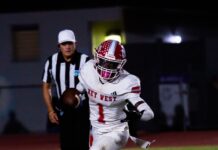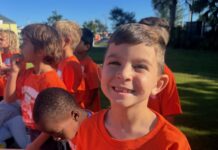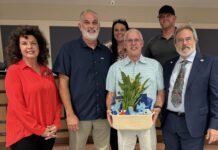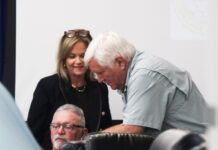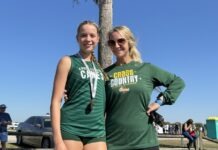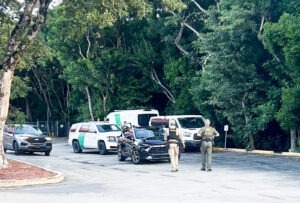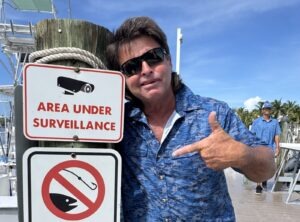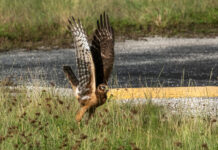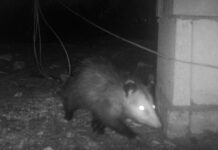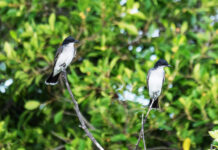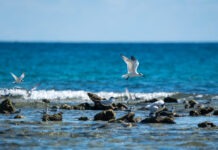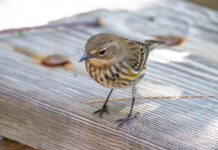The platform at the Florida Keys Hawkwatch, which is also the back deck of the bathhouse at the Curry Hammock State Park campground, was hopping. Though not as hopping as the skies overhead.
The sky was mostly clear and blue, with a slow, sparse display of clouds. And it was hot, so the birds were mostly high, a series of moving, fine-print runes waiting to be divined and translated into IDs and numbers.
Mid-October is almost always busy at the count site. But with Hurricanes Helene and Milton having passed, the migratory routes down the east coast and into the Florida peninsula had cleared, and it felt as if the cork had come out of a well-shaken bottle.
Gianna Arcuri and Chris Payne were the official counters, keeping an eye on the major flightlines, which were largely high and sometimes overhead. Tom Jordan from Portland, Oregon, was helping out, keeping an eye on the low horizon on the gulfside.
Anthony Sanchez, who works in the park and helps out at the counts sometimes, had a small array of clickers, each marked with a different species, laid out on one of the wide railings. Whenever someone called out a bird, he would click a button, sounding a bit like an old-school telegraph operator, sending dots and dashes out into the world, except it was all dots.
Workplaces tend to develop their own lingo, their own codes and shorthands. I’ve always been fond of diner slang, with phrases like “Adam and Eve on a raft, burn it,” meaning poached eggs on well-done toast, “cow paste” meaning butter, “halitosis” or “Italian perfume” meaning garlic, “nervous pudding” meaning Jell-O, and “on the hoof” meaning meat cooked rare.
Hanging at the hawkwatch on a busy day always reminds me of what it would be like if you crossed a diner with an airport control tower.
The conversation flows and rolls and crosses over itself into braids and tropes that are all about people trying to convey complicated information to each other, all in the service of counting every bird of prey it is possible to count flying over the site.
I decided to put my phone down and record a bit of it.
Gianna: Broad-wing, sharpie, PEFA.
Chris: Two turkey vultures.
Gianna: You see that a-sip that was just to the right of that peregrine behind your turkey?
Chris: Looks like a sharpie. Yeah. Back in the cloud, on the edge there’s a coop.
Tom: Anybody count these two turkey vultures?
Gianna and Chris: Yup.
Tom: And the two peregrines that went with them?
Gianna and Chris: Yup.
Chris: Sharpie. Sharpie. Another sharpie. Two sharpies and a broad wing. Coop. Two sharpies. A broad-wing. Adult peregrine.
Gianna: Did your peregrine just go through a little wisp of a cloud?
Chris: Yeah, a baby cloud on top of El Hefe. We got more birds coming. Osprey.
Anthony: Got it.
Chris: Adult peregrine. There’s another peregrine, but it’s going backwards.
Some translation: A sharpie is a sharp-shinned hawk, an accipiter. PEFA is the four-letter banding code for Peregrine falcon. The term a-sip is short for accipiter, a genus of short-winged, long-tailed, mostly-fearless hawks. Turkey is a turkey vulture. Coop is short for Cooper’s hawk, also an accipiter. El Hefe is a large tree in the campground. Going backwards means heading up the Keys instead of down the Keys.
Gianna: See where that turkey vulture is right now? It’s like salt and pepper.
Me: Oh geez. I haven’t seen a kettle like that in a long time.
Gianna: How do we wanna handle this?
Chris: You wanna go for broadies and I’ll try to pick stuff out?
Gianna: Sounds great.
Chris: I think with the tens, it’s harder to get these kettles, because I have a smaller field of view, so I feel like I miss a lot.
Tom: Out over the bay I have a shin.
Gianna: Okay, we are already in a glide, Chris.
Chris: Oh, gorgeous gray ghost.
Gianna: Straight up, Chris. We’re already in another glide out of the kettle. Are you on them?
Chris: Oh, it’s a beautiful gray ghost, isn’t it?
Me: Where’s the gray ghost?
Gianna: Can you add three kestrels, please?
Anthony: Got it.
Gianna: I had 101 broad-wings, and I’m still seeing a big kettle. Well, not big big. But like there’s still a good chunk of birds left out here.
Chris: Do you have this blue sky kettle?
Gianna: Yeah, I haven’t clicked it yet. But they’re gonna start gliding. I see a peregrine at the top. Do you see that?
Chris; I do not see a peregrine in the kettle I’m looking at. I see sharpies.
Anthony: Y’all are looking at different spots.
Tom: One kessie bayside. One PG bayside.
Some more translation: Brodies are broad-winged hawks. Tens are 10x binoculars, which have a longer reach, but a narrower field of view than, say, 8x binoculars. A shin is a sharp-shinned hawk. A glide is when a raptor, or group of raptors, reaches the top of a thermal and glides out in search of the next one. A gray ghost is an adult male northern harrier, called that because they tend to appear silently and swiftly, as if they’d apparated from another plane of existence. A PG is a Peregrine falcon.
Me: I’ve got a harrier straight up over me.
Gianna: Uh, I see. Wow. Look at ’em all tied up in his little glide.
Chris: (Scanning the sky without his binoculars.) Naked eyes do nothing at all. If people just walked up here and didn’t know, they’d just think we’re just, like, lying through our teeth, making stuff up.
These conversations have been edited for clarity and space.


